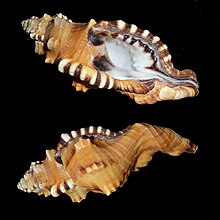Triton snails
| Triton snails | ||||||||||||
|---|---|---|---|---|---|---|---|---|---|---|---|---|

An Atlantic triton snail ( Charonia variegata ) eats a starfish |
||||||||||||
| Systematics | ||||||||||||
|
||||||||||||
| Scientific name | ||||||||||||
| Ranellidae | ||||||||||||
| Gray , 1854 |
The Triton snails (Ranellidae) are a family of mostly quite large snails that live exclusively in the sea . All representatives of the family are predators who live in tropical and subtropical seas.
features
The casings are right-hand wound and rolled up trochospirally. The mouth is usually oval with folded edges. The opening can be narrowed and modified by transverse ribs and "teeth" (protrusions). Often the lower end is pulled into a siphon channel. Some of the cases are heavily ornamented. The adult size ranges from 1.5 to 50 cm. The well developed foot is very muscular. The head has no or only a short snout. The antenna bases are strongly thickened. Therefore, the eyes on the antennae are relatively high above the actual head. The housing opening can be closed using an operculum . As far as is known, the family is of separate sex. The ontogenetic development is not uniform within the family. While the development usually takes place via a plankton-eating larva, nourishing eggs also occur, i. H. the embryo eats other, mostly unfertilized eggs in the clutch and hatches out of the protective clutch shell as a finished, small animal.
Way of life
Triton snails predatory feed on echinoderms , sea squirts , mussels and other snails. They live in all subtropical and tropical seas, mostly in the tidal range , in coral reefs , on rocky coasts and in sandy shallow water. The prey is mostly paralyzed by the secretions of the large salivary glands and z. T. probably also pre-digested. The prey is then swallowed whole or chopped up with the radula, depending on its size.
The preferred prey differs within the Ranellidae family: the conch horns (genus Charonia ) mainly eat echinoderms. Cabestana spengleri and Ranella australasia eat almost exclusively sea squirts, Septa parthenopium both mussels and sea squirts. Various representatives of the genus Cymatium , on the other hand, eat shell-bearing molluscs, depending on the species more like mussels or snails. Some Cymatium species, especially Cymatium muricinum , can become a problem in mussel farming.
Systematics
Millard (1997) and Riedel (2000) place the family in the superfamily Cassoidea, Ponder & Lindberg (1997) and Bouchet & Rocroi (2006) in the superfamily Tonnoidea. The family name Cassoidea was established by Latreille as early as 1825 and thus clearly had priority over Tonnoidea Suter, 1913 (cf. IRZN ).
The Ranellidae family is divided into two subfamilies:
- Cymatiinae Iredale, 1913
-
Ranellinae Gray, 1854
- Charonia tritonis (also conch)
- Cabestana cutacea (Linnaeus, 1767)
literature
- Philippe Bouchet, Jean-Pierre Rocroi: Part 2. Working classification of the Gastropoda. In: Malacologia. 47: 239-283, Ann Arbor 2005, ISSN 0076-2997 , archive.org , ConchBooks, ISBN 978-3-925919-72-5 .
- Victor Millard (Ed.): Classification of the Mollusca. A Classification of World Wide Mollusca. Rhine Road, South Africa 1997, ISBN 0-620-21261-6 , online (PDF; 2.46 MB), at olivirv.myspecies.info, accessed February 25, 2017.
- Betty Jean Piech: Ranellidae And Personidae: A Classification Of Recent Species. 60 pp., Delaware Museum of Natural History, Wilmington Del. 1995, OCLC 33600855 .
- Winston Ponder & David Lindberg : Towards a phylogeny of gastropod molluscs; an analysis using morphological characters. In: Zoological Journal of the Linnean Society. 119: 83-265, London 1997, ISSN 0024-4082 , doi: 10.1111 / j.1096-3642.1997.tb00137.x .
- Frank Riedel: Origin and evolution of the "higher" Caenogastropoda. Berliner Geoscientific Abhandlungen, Series E, Volume 32, Berlin 2000, ISBN 3-89582-077-6 .
- Richard Semon : On the purpose of excreting free sulfuric acid in sea snails. Biologisches Centralblatt 9, 1890, p. 80, online at biodiversitylibrary.org, accessed on February 25, 2017.
Web links
- Fischhaus Zepkow: Family Ranellidae - Triton snails
- Seashells of New South Wales: Family Ranellidae - Tritons and Trumpet Shells
- Ranellidae (= Cymatiidae) - Triton shells (identification key, English, on the FAO website ). From: JM Poutiers: Gastropods. In: Kent E. Carpenter, Volker H. Niem (Eds.): FAO Species identification guide for fishery purposes. The living marine resources of the Western Central Pacific. Volume 1: Seaweeds, corals, bivalves and gastropods. Food and Agriculture Organization of the United Nations, Rome, 1998.
- ITIS report
- Animal Diversity Web
- National Center for Biotechnology Information
- jaxshells.org - Family Ranellidae
Individual evidence
- ↑ Hugh Govan: Cymatium muricinum and Other Ranellid Gastropods: Major Predators of Cultured Tridacnid Clams (PDF; 3.0 MB) . ICLARM Technical Reports 49. Manila, 1995. 150 pages.

